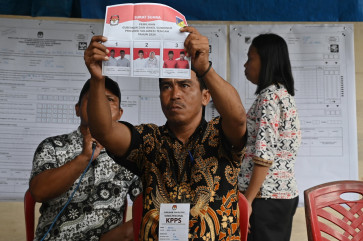Popular Reads
Top Results
Can't find what you're looking for?
View all search resultsPopular Reads
Top Results
Can't find what you're looking for?
View all search resultsHalloween, ‘kuntilanak’ and cultural identity
Thanks to globalization, many urban Indonesians now celebrate Halloween
Change text size
Gift Premium Articles
to Anyone
T
hanks to globalization, many urban Indonesians now celebrate Halloween.
Halloween falls on Oct. 31 and is celebrated in department stores, restaurants, cafes and even in schools and other educational institutions. Both children and adults are invited to Halloween parties where costumes are worn, and the games, music and decorations are Halloween-themed.
Some multicultural institutions holding Halloween parties offer fresh ideas about cultural identity, and hope their students will share cultural experiences with one another.
Parents and teachers put a lot of effort into preparing children’s costumes that represent the western idea of the supernatural, such as zombies, devils, mummies, skeletons and other similar archetypess. They might also try to include local, on-screen characters that haunt televisions and cinemas, like kuntilanak and sundel bolong.
Indonesians tend to celebrate Halloween without finding out anything about its origins, history or significance. Most Halloween party organizers do not care why and how this tradition was born in the first place.
Today, those global and local symbols of horror have become more and more popular. Together, they join forces and reinforce fantasies and myths. The myth of the kuntilanak rose from a belief that a woman would become one if she died in childbirth, and her spirit would wander around aimlessly. Sundel bolong is a female ghost who wants to take revenge on all men because when she was alive, she was gang raped and committed suicide as a result.
These interpretations of kuntilanak and sundel bolong have been continuously exploited in local TV shows and movies over the years, instilling the misperception that women who die as victims of wrong deeds could somehow become evil and hateful ghosts. This interpretation bears no relation to the real fate of women who are victims of sexual violence or who die in childbirth.
Observing a tradition should be an opportunity to re-interpret cultural archetypes in a critical and insightful manner. Sadly things seem to be happening the other way round: The history of a tradition is neglected and it is simply adapted to current trends.
In such spirit, Indonesian urban community, in particular children, need to know that Halloween is an ancient tradition linked to the Celtic festival of Samhain (summer’s end), the conclusion of the harvest and the start of winter, or the “darker half” of the year. It was a time for reflection and to get ready for the cold winter ahead; cattle were brought down from summer pastures and livestock was slaughtered. Bonfires were lit and there were rituals that may have once entailed human sacrifice. People believed that the door to the “Otherworld” opened at this time and the souls of the dead, fairies, and other supernatural beings could enter our world
This explanation certainly has no connection to the tragic tales of kuntilanak and sundel bolong, which are manipulated as exemplary stories of life today.
If the original message of Halloween is delivered, children will have even richer cultural experiences and develop stronger identities as they learn and are taught pluralism-based interpretations rather than shallow sinetron views of life.
Offering fresh interpretations of traditional celebrations should be both an opportunity and challenge for educational institutions. Children should receive information, knowledge and cultural experience in true contexts and with real meaning. From an early age, children need to be trained to be critical and to sharpen their wits, and be
encouraged to accept new ideas.
Only through facts and simple interpretations, can children define the meaning of a symbol and the significance of a cultural event like Halloween.
The writer is a community media activist.










